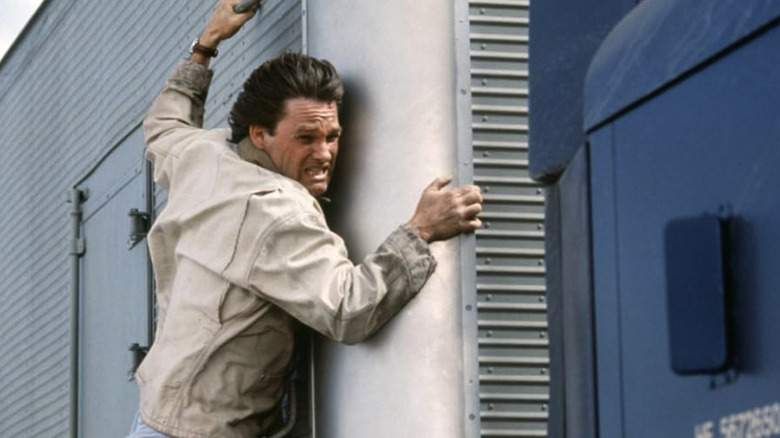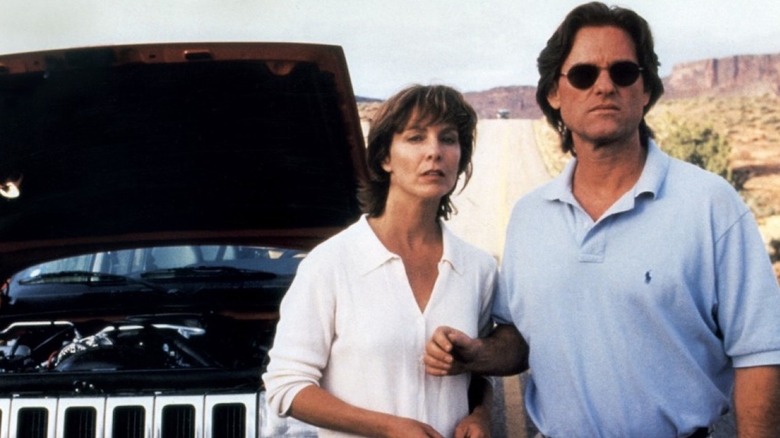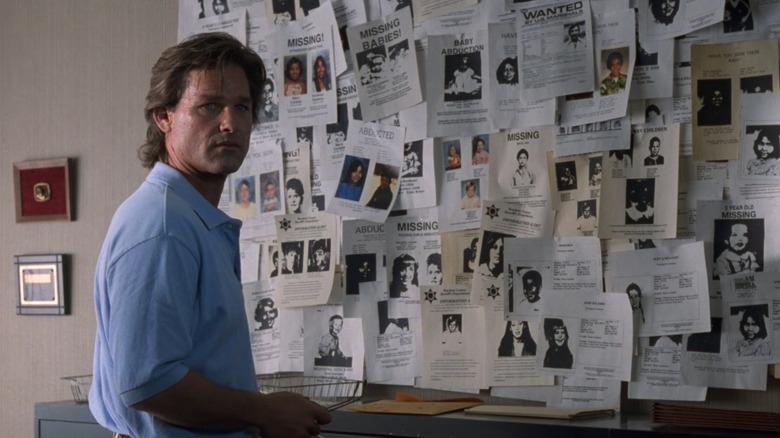Kurt Russell's Daily Commute For Breakdown Was Anything But Ordinary
In Jonathan Mostow's 1997 thriller "Breakdown," Kurt Russell and Kathleen Quinlan play a happily married couple driving their high-tech SUV from Boston to San Diego. By accident, they almost run into a pickup truck on the remote highways of Arizona. When Russell later meets the driver of the pickup (M.C. Gainey) at a gas station, tensions are high. Later still, when Russell and Quinlan are back on the road, their car suddenly stops. Quinlan offers to hitchhike into town to get help, while Russell stays with the SUV. It will be quite a while before they see each other again. It seems that Quinlan has been kidnapped! Russell has to drive around Arizona's remote backroads looking for clues, and eventually, he faces off against the kidnappers. "Breakdown" also stars the immortal J.T. Walsh, and a punky Jack Noseworthy.
The film is Hitchcockian in its trimness, and Mostow wrings every bit of tension out of his screenplay (which he co-wrote with Sam Montgomery). It was a modest hit in 1997, but is well-remembered by those who either saw it in theaters, or who accumulated it on VHS over the ensuing years.
In 2021, Mostow was interviewed by Forbes Magazine, and the filmmaker recalled the fun and excitement he had on the set of "Breakdown." He also revealed that the film ballooned into something far larger than he originally intended. Mostow conceived of "Breakdown" as a low-budget thriller along the lines of Steven Spielberg's "Duel," or one of the many B-grade car-based Australian thrillers from the 1980s. The ultimate budget for "Breakdown" ended up being $36 million, and a large chunk of that went to actors' salaries, as well as a private jet for Russell that would allow him to commute out to the Arizona desert from his Los Angeles home every morning.
Kurt Russell's private jet
As the Forbes interview points out, "Breakdown" has a passionate following. When asked if Mostow had predicted a slow expansion of his film's popularity, the director admitted he expected almost the opposite. He likely suspected he would release a zero-budget B-movie and merely hope someone somewhere bothered to buy a ticket. His ambitions, he said, were low. To quote:
"I had initially conceived 'Breakdown' as something I could do on a super low budget. I could shoot it out in the desert, I didn't need to pay for lights because we'll be mostly in daylight, and I didn't need location permits or expensive locations because it was out in the middle of nowhere. 'Breakdown' was very early in my career, and the film I'd done right before this, I'd made for only $1 million, so in my mind, it was a movie that I was going to make for maybe $4 million."
The $1 million film in question was the 1989 horror comedy "Beverly Hills Bodysnatchers" which starred former "Batman" actor Frank Gorshin and Victor Tayback. Sadly, the film is not currently available on streaming. (Freelance archivists, however, have retained it on YouTube.)
Mostow expressed shock that "Breakdown" mutated from a modest B-picture into a proper studio thriller. In the interview, he revealed that the upgrade in production value was distressing, and that Kurt Russell's commute was astonishing; it was not something a B-movie would have accommodated. He said:
"When it suddenly turned into a studio-sized film, with a big movie star, who was commuting to set every day from his house in Los Angeles by private jet, and I had this huge crew, I started to worry it was going to be the Emperor with no clothes."
But Mostow availed himself well.
Why Kurt Russell commuted
One might note that Russell and his longtime partner Goldie Hawn rarely released films in the same year. This was because of a personal arrangement between them that ensured at least one of them would be home taking care of their children while the other traveled out to make a movie. Russell and Hawn took turns. In 1996, when Russell was scheduled to shoot "Breakdown," he was coming off the John Carpenter's dystopian sci-fi film "Escape from L.A.," and it was to be Hawn's turn next.
For "Breakdown," Russell demanded a certain level of respect and parental assurance. It's also possible that he simply didn't want to spend his nights in a small, remote Arizona motel for the length of the film's shooting. "For him," Mostow said, "a good quality of life is essential." When Russell said that it was Hawn's turn to make a movie, the film's producer, original "Dune" producer Dino De Laurentiis, said that Russell could make it to the set every day if he commuted. Hence, the private jet. Mostow said:
"Kurt would be finishing 'Escape from L.A.,' so he said to 'Breakdown's' producer, Dino De Laurentiis, that he would have to wait until the following year because it was Goldie's turn to do a movie. Dino, in his classic way, said, 'No problem. I'll solve that.' Flying him back and forth was the solution, so every night Kurt was home for dinner, he'd be back in his bed, and the following morning he'd fly to set in Utah or wherever and do his scenes, then he'd fly home again."
No doubt the commute caused the budget to skyrocket, but if De Laurentiis was willing to shell out, then Mostow was okay with it. All in all, they made a pretty excellent thriller for their troubles.


